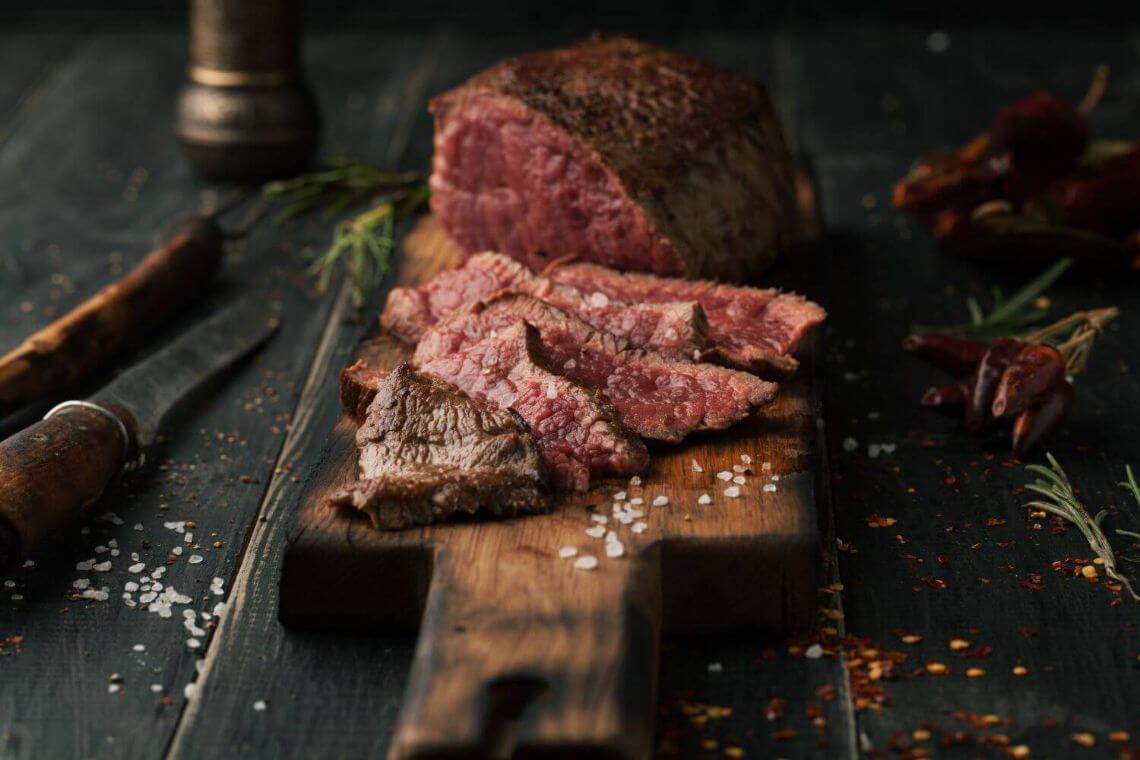Gallagher’s Butchers Castlefinn
Steak

100% Natural, 100% Local

Professional meat cutting

Click & Collect Service

Quality & Standards
Gallagher’s First for Steak
Award Winning Steak
Best Butcher Donegal Steak from our Prime Beef cattle reared on our own farm in the Finn Valley. That’s right we have won awards for it. “Look at the marbling on that.” “Best marbled steak in Ireland.”
A good sign for a butcher steak is where they supply local restaurants and hotels. Chefs are very particular – they want the best cut for the best value so a butcher who supplies steak to the chefs of these establishments knows their steak and only supplies the best.
Brendan Gallagher of Gallagher’s Butchers Castlefinn, has been supplying hotels and restaurants for years. So if you want restaurant quality steak in the comfort of your own home – look no further.

What is Marbling?
Marbling is the white flecks of intramuscular fat in each cut of meat. It is called marbling because it resembles a marble pattern. Marbling adds a lot of flavour and can be one indicator of how good the beef is. It impacts the tenderness, moistness, and overall flavour . Because of this the extent of marbling has become one of the most well-known elements of steak evaluation.

How Do you Get Marbled Beef Steak?
The quality of the animal, how it is reared and what it is fed on make a huge difference to the end product. Grass fed prime beef on the rich pasture of the Finn Valley has always produced for us the best quality cuts of beef . What you are looking for ideally is good lean muscle with not too much subcutaneous fat. A lean animal like that should have a good spread of intramuscular fat ie nicely marbled.
What Does Marbling Do?
The more spread out the fat is in small amounts throughout the meat the more tender the cut when cooked. So choose a nicely marbled steak, a Gallagher’s Best Butcher Donegal Steak.
Does that mean it’s Fatty?
No, the fat renders off a nicely marbled steak easily during the cooking process keeping the meat moist. This leaves you with a juicy, tender, lean, pure protein meal. In fact if cooked properly you could practically cut it with a spoon!
How do you know how much fat is good?
When shopping for steaks, it is down to the individuals preference but it’s often best to seek a happy medium between lean and fatty. Look for nicely marbled steaks, but not completely riddled with fat throughout. For a tender cut try fillet, ribeye or sirloin. For those with a bigger appetite try our 21 day dry-aged T-Bones or Tomahawks.

Gallagher’s Best Butcher Donegal
Cooking the Perfect Steak
- Instructions
- 1. Have steak at room temperature
- 2. Heat a frying pan to smoking point
- 3. Rub a little oil and seasoning onto your steak, not the pan
- 4. For a medium steak, fry on the pan for 3mins on one side
- 5. Then turn over and cook for another 4mins
- 6. Rest for 3mins
- 7. Serve with sauce of your choice.
Gallagher’s Best Butcher Donegal
How to Choose the Best Butcher Donegal Steak for You
Loin Steaks
If you’re looking for the most tender steak possible, choose one that’s cut from the loin of the animal. The loin sits below the backbone; because this area gets less exercise than others parts of the animal, the loin is the source of some of the best cuts of meat for a juicy, tender steak.
Type of Steak: Fillet, T Bone, Tomahawk, Rib eye, Sirloin Steak
Best Way to Cook: Grill, pan fry , grill pan (gives nice grill lines on the steak)
When diced, sirloin steak is also great for quick-cooking stirfrys.
For more even cooking, let these beef steak cuts stand at room temperature about 30 minutes before searing.
Mid Bottom Section
The plate and the flank sit in the midbottom section of the animal. These two areas contain the skirt steak, known for its bold flavor, and the flank steak, which is also a cut full of flavour.
Type of Steak: Skirt Steak, Flank Steak
Best Way to Cook: Marinate before grilling, or stir-frying. Alternatively you braise it as this adds moisture to the cooking process giving a nice tender dish.
Topside, Silverside, Rump and Round
These beef steak cuts come from the hind quarter of the animal. Because the muscles in this area have been toughened by exercise, these steaks are leaner and less tender than most other beef steak cuts. They are full of flavour and more economical than the loin cuts.
Type of Steak: Topside, Round Steak, Silverside and Chump/Rump
Best Way to Cook: Rump – best for frying, stirfrys and casseroles. Topside, Silverside and Eye of Round/Salmon Cut are best for roasting. Alternatively you braise any of these cuts as this adds moisture to the cooking process.
Slow cooking definitely suits these cuts. Why not try our best butcher Donegal round steak diced beef – lovely in a casserole.
Forequarter Cuts
They come from the forequarter – neck shoulder and breast of the animal.
Type of Steak: Brisket ideal for your slow cooker, Chuck ideal for casseroles and stews.Housekeepers cuts ideal for roasting

Gallagher’s Best Butcher Donegal
How do you test how well done your Steak is?
Try the finger touch test – using only your thumb and forefinger test for the different grades of “doneness” – rare, medium, well done.
Click here to test if Steak is Done →
Best Butcher
Brendan Gallagher
Winner of Outstanding Presentation Award at 2015 European Angus Steak Tasting Competition
Contact us to try out our Best Butcher Donegal Steak.

